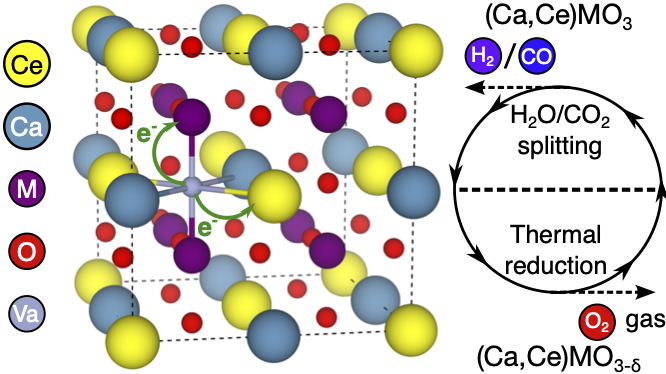Abstract
Solar thermochemical (STC) processes hold promise as efficient ways to generate renewable fuels, fuel precursors, or chemical feedstocks using concentrated sunlight. Specifically, one actively researched approach is the two-step STC cycle, which uses a redox-active, off-stoichiometric, transition-metal oxide material to split water and/or CO2, generating H2 and/or CO, respectively, or syngas (a combination of H2 and CO). Identifying novel metal oxides that yield larger reduction extents (practically achievable off-stoichiometries) than the state-of-the-art CeO2 is critical. Here, we explore the chemical space of Ca–Ce–M–O (M = 3d transition metal, except Cu and Zn) metal oxide perovskites, with Ca and/or Ce occupying the A site and M occupying the B site within an ABO3 framework, as potential STC candidates. We use density functional theory (DFT)-based calculations and systematically evaluate the oxygen vacancy (VaO) formation energy (≈ enthalpy of reduction in an STC cycle), electronic properties, thermodynamic stability of CaMO3, CeMO3, and Ca0.5Ce0.5MO3 perovskites, and the VaO formation energy within Ca0.5Ce0.5Ti0.5Mg0.5O3 perovskite. We consider only Ca and/or Ce on the A site because of their similar size and the potential redox activity of Ce4+. If both Ce and M exhibit simultaneous reduction with VaO formation, the resulting perovskite could exhibit a larger entropy of reduction than a single cation reduction. The increased entropy produces increased reduction for fixed temperature, partial pressure of oxygen, and reduction enthalpy, and therefore increased STC efficiency. Importantly, we identify Ca0.5Ce0.5MnO3, Ca0.5Ce0.5FeO3, and Ca0.5Ce0.5VO3 to be promising candidates based on their VaO formation energy and thermodynamic (meta)stability. Moreover, based on our calculated on-site magnetic moments, electron density of states, and electron density differences between pristine and defective structures, we find Ca0.5Ce0.5MnO3 to exhibit simultaneous reduction of both Ce4+ (A-site) and Mn3+ (B-site), highlighting a particularly promising candidate for STC applications with a predicted higher entropy of reduction than CeO2. Finally, we extract metrics that govern the trends in VaO formation energies, such as standard reduction potentials, and provide pointers for further experimental and theoretical studies, which will enable the design of improved materials for the STC cycle.
